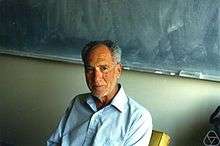Gerhard Hochschild
Gerhard Paul Hochschild (April 29, 1915 in Berlin – July 8, 2010 in El Cerrito, California) was a German-born American mathematician who worked on Lie groups, algebraic groups, homological algebra and algebraic number theory.

Early life
On April 29, 1915, Hochschild was born in Berlin, Germany.[1] Hochschild's father was a patent attorney who had an engineering degree. Hochschild had an older brother.[1]
Education
In 1936, Hochschild earned a BS degree in mathematics from University of Cape Town in Union of South Africa.[1] In 1937, Hochschild earned a MS degree in mathematics from University of Cape Town.[1] In 1941, Hochschild earned his PhD in mathematics from Princeton University.[1] Hochschild completed his thesis in 1941 at Princeton University with Claude Chevalley on Semisimple Algebras and Generalized Derivations.
Career
In 1956–7 Hochschild was at the Institute for Advanced Study. Hochschild was a professor at University of Illinois at Urbana-Champaign. In the late 1950s Hochschild was a professor at University of California, Berkeley.
Hochschild (1945) introduced Hochschild cohomology, a cohomology theory for algebras, which classifies deformations of algebras. Hochschild & Nakayama (1952) introduced cohomology into class field theory. Along with Bertram Kostant and Alex F. T. W. Rosenberg, the Hochschild–Kostant–Rosenberg theorem is named after him.[2]
Among his students were Andrzej Białynicki-Birula and James Ax.
In 1955, Hochschild was a Guggenheim Fellow. In 1979 Hochschild was elected to the National Academy of Sciences, and in 1980 he was awarded the Leroy P. Steele Prize of the AMS.
In 1982, Hochschild retired but continued teaching part-time until 1985.[1]
Personal life
Hochschild's wife was Ruth. Hochschild's children are Ann Hochschild and Peter Hochschild.[1]
On July 8, 2010, Hochschild died at his home. Hochschild was 95.[1]
See also
Publications
- Hochschild, G. (1945), "On the cohomology groups of an associative algebra", Annals of Mathematics, Second Series, 46: 58–67, doi:10.2307/1969145, ISSN 0003-486X, JSTOR 1969145, MR 0011076
- Hochschild, G.; Nakayama, Tadasi (1952), "Cohomology in class field theory", Annals of Mathematics, Second Series, 55: 348–366, doi:10.2307/1969783, ISSN 0003-486X, JSTOR 1969783, MR 0047699
- Hochschild, G. (1965), The structure of Lie groups, San Francisco, Calif.: Holden–Day Inc., MR 0207883
- Hochschild, G. (1971), Introduction to affine algebraic groups, San Francisco, Calif.: Holden–Day Inc., MR 0277535
- Hochschild, Gerhard Paul (1981), Basic theory of algebraic groups and Lie algebras, Graduate Texts in Mathematics, 75, Berlin, New York: Springer-Verlag, ISBN 978-0-387-90541-9, MR 0620024
- Hochschild, Gerhard Paul (1983), Perspectives of elementary mathematics, Berlin, New York: Springer-Verlag, ISBN 978-0-387-90848-9, MR 0710303
References
- "IN MEMORIAM Gerhard Hochschild". universityofcalifornia.edu. Retrieved December 22, 2018.
- Porter, Tim (April 8, 2014), "Hochschild-Kostant-Rosenberg theorem", nLab.
- Moore, Calvin C.; Ribet, Kenneth A.; Wolf, Joseph A. (2011), IN MEMORIAM Gerhard Hochschild Professor of Mathematics, Emeritus UC Berkeley 1915 - 2010, archived from the original on 2011-09-15
- Ferrer Santos, Walter (2011). "Gerhard Hochschild (1915/2010) A Mathematician of the XXth Century". arXiv:1104.0335.
- Ferrer Santos, Walter; Moskowitz, Martin, eds. (2011), "Gerhard Hochschild (1915-2010)" (PDF), Notices of the American Mathematical Society, 58 (8): 1078–1099, ISSN 0002-9920
External links
| Wikiquote has quotations related to: Gerhard Hochschild |
- Gerhard Hochschild at the Mathematics Genealogy Project
- Pictures of Gerhard Hochschild from Oberwolfach
- Finding Aid to the Gerhard P. Hochschild papers, 1941-2004, The Bancroft Library
- Hochschild Family Foundation at foundation center.org